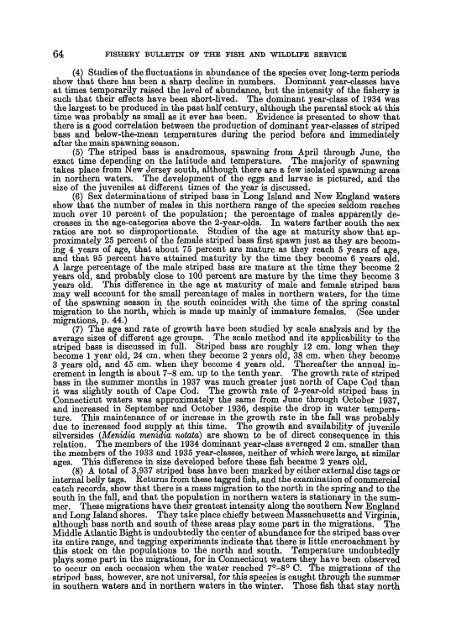Fishery bulletin of the Fish and Wildlife Service - NOAA
Fishery bulletin of the Fish and Wildlife Service - NOAA
Fishery bulletin of the Fish and Wildlife Service - NOAA
You also want an ePaper? Increase the reach of your titles
YUMPU automatically turns print PDFs into web optimized ePapers that Google loves.
64 FISHERY BULLETIN OF THE FISH AND WILDLIFE SERVICE<br />
(4) Studies <strong>of</strong> <strong>the</strong> fluctuations in abundance <strong>of</strong> <strong>the</strong> species over, long-term periods<br />
show that <strong>the</strong>re has been a sharp decline in numbers. Dominant year-classes have<br />
at times temporarily raised <strong>the</strong> level <strong>of</strong> abundance, but <strong>the</strong> intensity <strong>of</strong> <strong>the</strong> fishery is<br />
such that <strong>the</strong>ir effects have been short-lived. The dominant year-class <strong>of</strong> 1934 was<br />
<strong>the</strong> largest to be produced in <strong>the</strong> past half century, although <strong>the</strong> parental stock at this<br />
time was probably as small as it ever has been. Evidence is presented to show that<br />
<strong>the</strong>re is a good correlation between <strong>the</strong> production <strong>of</strong> dominant year-classes <strong>of</strong> striped<br />
bass <strong>and</strong> oelow-<strong>the</strong>-mean temperatures during <strong>the</strong> period before <strong>and</strong> immediately<br />
after <strong>the</strong> main spawning season.<br />
(5) The striped bass is anadromous, spawning from April through June, <strong>the</strong><br />
exact time depending on <strong>the</strong> latitude <strong>and</strong> temperature. The majority <strong>of</strong> spawning<br />
takes place from New Jersey south, although <strong>the</strong>re are a few isolated spawning areas<br />
in nor<strong>the</strong>rn waters. The development <strong>of</strong> <strong>the</strong> eggs <strong>and</strong> larvae is pictured, <strong>and</strong> <strong>the</strong><br />
size <strong>of</strong> <strong>the</strong> juveniles at different times <strong>of</strong> <strong>the</strong> year is discussed.<br />
(6) Sex determinations <strong>of</strong> striped bass in Long Isl<strong>and</strong> <strong>and</strong> New Engl<strong>and</strong> waters<br />
show that <strong>the</strong> number <strong>of</strong> males in this nor<strong>the</strong>rn range <strong>of</strong> <strong>the</strong> species seldom reaches<br />
much over 10 percent <strong>of</strong> <strong>the</strong> population; <strong>the</strong> percentage <strong>of</strong> males apparently decreases<br />
in <strong>the</strong> age-categories above <strong>the</strong> 2-year-olds. In waters far<strong>the</strong>r south <strong>the</strong> sex<br />
ratios are not so disproportionate. Studies <strong>of</strong> <strong>the</strong> age at maturity show that approximately<br />
25 percent <strong>of</strong> <strong>the</strong> female striped bass first spawn just as <strong>the</strong>y are becoming<br />
4 years <strong>of</strong> age, that about 75 percent are mature as <strong>the</strong>y reach 5 years <strong>of</strong> age,<br />
<strong>and</strong> that 95 percent have attained maturity by <strong>the</strong> time <strong>the</strong>y become 6 years old.<br />
A large percentage <strong>of</strong> <strong>the</strong> male striped bass are mature at <strong>the</strong> time <strong>the</strong>y become 2<br />
years old, <strong>and</strong> probably close to 100 percent are mature by <strong>the</strong> time <strong>the</strong>y become 3<br />
years old. This difference in <strong>the</strong> age at maturity <strong>of</strong> male <strong>and</strong> female striped bass<br />
may well account for <strong>the</strong> small percentage <strong>of</strong> males in nor<strong>the</strong>rn waters, for <strong>the</strong> time<br />
<strong>of</strong> <strong>the</strong> spawning season in <strong>the</strong> south coincides with <strong>the</strong> time <strong>of</strong> <strong>the</strong> spring coastal<br />
migration to <strong>the</strong> north, which is made up mainly <strong>of</strong> immature females. (See under<br />
migrations, p. 44.)<br />
(7) The age <strong>and</strong> rate <strong>of</strong> growth have been studied by scale analysis <strong>and</strong> by <strong>the</strong><br />
average sizes <strong>of</strong> different age groups. The scale method <strong>and</strong> its applicability to <strong>the</strong><br />
striped bass is discussed in full. Striped bass are roughly 12 cm. long when <strong>the</strong>y<br />
become 1 year old, 24 cm. when <strong>the</strong>y become 2 years old, 38 cm. when <strong>the</strong>y become<br />
3 years old. <strong>and</strong> 45 cm. when <strong>the</strong>y become 4 years old. Thereafter <strong>the</strong> annual increment<br />
in length is about 7-8 cm. up to <strong>the</strong> tenth year. The growth rate <strong>of</strong> striped<br />
bass in <strong>the</strong> summer months in 1937 was much greater just north <strong>of</strong> Cape Cod than<br />
it was slightly south <strong>of</strong> Cape Cod. The growth rate <strong>of</strong> 2-year-old striped bass in<br />
Connecticut waters was approximately <strong>the</strong> same from June through October 1937,<br />
<strong>and</strong> increased in September <strong>and</strong> October 1936, despite <strong>the</strong> drop in water temperature.<br />
This maintenance <strong>of</strong> or increase in <strong>the</strong> growth rate in <strong>the</strong> fall was probably<br />
due to increased food supply at this time. The growth <strong>and</strong> availability <strong>of</strong> juvenile<br />
silversides (Menidia menidia notata) are shown to be <strong>of</strong> direct consequence in this<br />
relation. The members <strong>of</strong> <strong>the</strong> 1934 dominant year-class averaged 2 cm. smaller than<br />
<strong>the</strong> members <strong>of</strong> <strong>the</strong> 1933 <strong>and</strong> 1935 year-classes, nei<strong>the</strong>r <strong>of</strong> which were large, at similar<br />
ages. This difference in size developed before <strong>the</strong>se fish became 2 years old.<br />
(8) A total <strong>of</strong> 3,937 striped bass have been marked by ei<strong>the</strong>r external disc tags or<br />
internal belly tags. Returns from <strong>the</strong>se tagged fish, <strong>and</strong> <strong>the</strong> examination <strong>of</strong> commercial<br />
catch records, show that <strong>the</strong>re is a mass migration to <strong>the</strong> north in <strong>the</strong> spring <strong>and</strong> to <strong>the</strong><br />
south in <strong>the</strong> fall, <strong>and</strong> that <strong>the</strong> population in nor<strong>the</strong>rn waters is stationary in <strong>the</strong> summer.<br />
These migrations have <strong>the</strong>ir greatest intensity along <strong>the</strong> sou<strong>the</strong>rn New Engl<strong>and</strong><br />
<strong>and</strong> Long Isl<strong>and</strong> shores. They take place chiefly between Massachusetts <strong>and</strong> Virginia,<br />
although bass north <strong>and</strong> south <strong>of</strong> <strong>the</strong>se areas play some part in <strong>the</strong> migrations. The<br />
Middle Atlantic Bight is undoubtedly <strong>the</strong> center <strong>of</strong> abundance for <strong>the</strong> striped bass over<br />
its entire range, <strong>and</strong> tagging experiments indicate that <strong>the</strong>re is little encroachment by<br />
this stock on <strong>the</strong> populations to <strong>the</strong> north <strong>and</strong> south. Temperature undoubtedly<br />
plays some part in <strong>the</strong> migrations, for in Connecticut waters <strong>the</strong>y have been observed<br />
to occur on each occasion when <strong>the</strong> water reached 7°-8° C. The migrations <strong>of</strong> <strong>the</strong><br />
striped bass, however, are not universal, for this species is caught through <strong>the</strong> summer<br />
in sou<strong>the</strong>rn waters <strong>and</strong> in nor<strong>the</strong>rn waters in <strong>the</strong> winter. Those fish that stay north

















